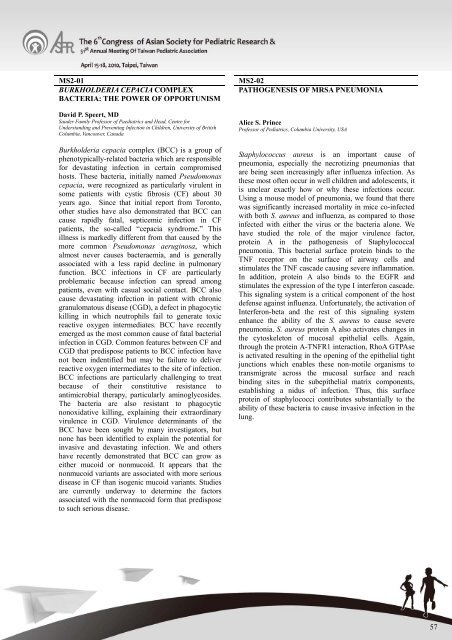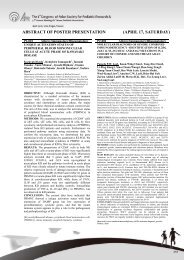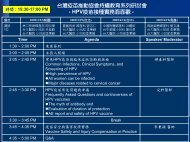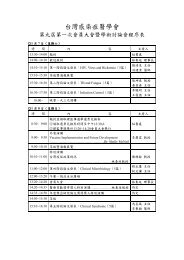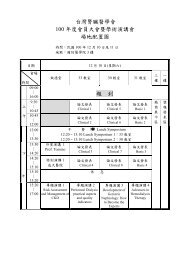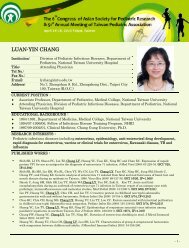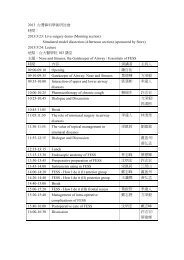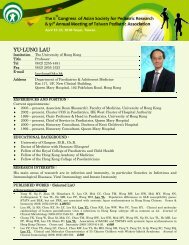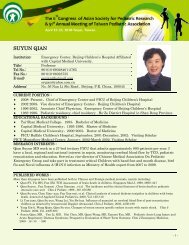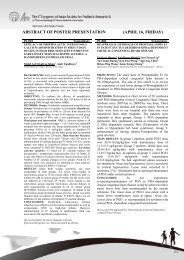ABSTRACT OF INVITED LECTURES AND ORAL PRESENTATION
ABSTRACT OF INVITED LECTURES AND ORAL PRESENTATION
ABSTRACT OF INVITED LECTURES AND ORAL PRESENTATION
- No tags were found...
You also want an ePaper? Increase the reach of your titles
YUMPU automatically turns print PDFs into web optimized ePapers that Google loves.
MS2-01BURKHOLDERIA CEPACIA COMPLEXBACTERIA: THE POWER <strong>OF</strong> OPPORTUNISMDavid P. Speert, MDSauder Family Professor of Paediatrics and Head, Centre forUnderstanding and Preventing Infection in Children, University of BritishColumbia, Vancouver, CanadaBurkholderia cepacia complex (BCC) is a group ofphenotypically-related bacteria which are responsiblefor devastating infection in certain compromisedhosts. These bacteria, initially named Pseudomonascepacia, were recognized as particularly virulent insome patients with cystic fibrosis (CF) about 30years ago. Since that initial report from Toronto,other studies have also demonstrated that BCC cancause rapidly fatal, septicemic infection in CFpatients, the so-called “cepacia syndrome.” Thisillness is markedly different from that caused by themore common Pseudomonas aeruginosa, whichalmost never causes bacteraemia, and is generallyassociated with a less rapid decline in pulmonaryfunction. BCC infections in CF are particularlyproblematic because infection can spread amongpatients, even with casual social contact. BCC alsocause devastating infection in patient with chronicgranulomatous disease (CGD), a defect in phagocytickilling in which neutrophils fail to generate toxicreactive oxygen intermediates. BCC have recentlyemerged as the most common cause of fatal bacterialinfection in CGD. Common features between CF andCGD that predispose patients to BCC infection havenot been indentified but may be failure to deliverreactive oxygen intermediates to the site of infection.BCC infections are particularly challenging to treatbecause of their constitutive resistance toantimicrobial therapy, particularly aminoglycosides.The bacteria are also resistant to phagocyticnonoxidative killing, explaining their extraordinaryvirulence in CGD. Virulence determinants of theBCC have been sought by many investigators, butnone has been identified to explain the potential forinvasive and devastating infection. We and othershave recently demonstrated that BCC can grow aseither mucoid or nonmucoid. It appears that thenonmucoid variants are associated with more seriousdisease in CF than isogenic mucoid variants. Studiesare currently underway to determine the factorsassociated with the nonmucoid form that predisposeto such serious disease.MS2-02PATHOGENESIS <strong>OF</strong> MRSA PNEUMONIAAlice S. PrinceProfessor of Pediatrics, Columbia University, USAStaphylococcus aureus is an important cause ofpneumonia, especially the necrotizing pneumonias thatare being seen increasingly after influenza infection. Asthese most often occur in well children and adolescents, itis unclear exactly how or why these infections occur.Using a mouse model of pneumonia, we found that therewas significantly increased mortality in mice co-infectedwith both S. aureus and influenza, as compared to thoseinfected with either the virus or the bacteria alone. Wehave studied the role of the major virulence factor,protein A in the pathogenesis of Staphylococcalpneumonia. This bacterial surface protein binds to theTNF receptor on the surface of airway cells andstimulates the TNF cascade causing severe inflammation.In addition, protein A also binds to the EGFR andstimulates the expression of the type I interferon cascade.This signaling system is a critical component of the hostdefense against influenza. Unfortunately, the activation ofInterferon-beta and the rest of this signaling systemenhance the ability of the S. aureus to cause severepneumonia. S. aureus protein A also activates changes inthe cytoskeleton of mucosal epithelial cells. Again,through the protein A-TNFR1 interaction, RhoA GTPAseis activated resulting in the opening of the epithelial tightjunctions which enables these non-motile organisms totransmigrate across the mucosal surface and reachbinding sites in the subepithelial matrix components,establishing a nidus of infection. Thus, this surfaceprotein of staphylococci contributes substantially to theability of these bacteria to cause invasive infection in thelung.57


